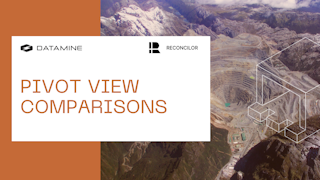Pivot View
The Pivot View screen in Reconcilor is designed to help you summarise and compare large volumes of data. It lets you load the metrics you want to analyse – such as tonnes, grade, metal – or load preconfigured comparisons for analysis. Together, metrics and comparisons allow you to focus on the measures that matter and clearly see how results align across the value chain.
In the Pivot View, you select dimensions (or fields) from the available listing in the dataset to construct your own query – very similar to using a pivot table in Microsoft Excel.
It is important to note however, that when using the Pivot View to generate queries and charts, you must keep the 'isolate and act' philosophy in mind. In other words, generate comparisons that test a known variable.
This approach is critical for reconciliation because it allows you to measure bias (systematic over- or under-reporting) and variance (inconsistency in results). By grouping data by pit, ore body, domain, or time period, you can move from high-level summaries to detailed analysis that explains where and why differences occur.
The Pivot View provides access to the data warehouse which is the source for the data analysis modules.
With Pivot View, you have the flexibility to determine the table structure according to specific needs. The Pivot View's tables and charts can be saved as saved configurations and can be published to the Dashboard.



